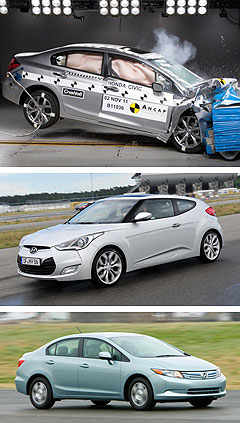Make / Model Search
News - Hyundai - VelosterHonda Civic, Hyundai Veloster win five starsSmashing effort: The Hyundai Veloster aced the front impact crash test on its way to the maximum five-star result. Small cars make the five-star safety grade, despite ANCAP’s stiffer crash test rules3 Feb 2012 TWO small cars about to arrive in Australian showrooms have each scored five-star crash safety ratings under the tougher 2012 Australian New Car Assessment Program (ANCAP) rules that now take pedestrian protection into account. The Honda Civic sedan – heading the ninth generation that is due to go on sale next month – and the all-new Hyundai Veloster small sports coupe – to be launched to the motoring media next week – both made the grade for the maximum star rating, although both showed some flaws. The Veloster – tested in European left-hand drive 1.6-litre GDI GLS guise – aced the crash tests, scoring 15.47 out of a possible 16 in the front offset test, 16 out of 16 in the side impact test and maximum two points for the side pole test. However, it was let down in the new pedestrian protection tests, scoring only 17.74 out of a possible 36, for an “acceptable” rating. Its overall occupant protection score was 35.47 out of 37, pushing it into five-star territory. The Civic scored a much better 27.54 out of 36 in the pedestrian tests for a maximum “good” rating – the best yet recorded by ANCAP under the new testing regime that the independent organisation calls its ‘road map’.  Left: Civic frontal crash test. Below: Hyundai Veloster and Honda Civic sedan. Left: Civic frontal crash test. Below: Hyundai Veloster and Honda Civic sedan.ANCAP chairman Lauchlan McIntosh said Honda should be congratulated on achieving ANCAP’s highest result in that aspect of the testing. “Pedestrian protection is an area that has not been well addressed amongst the current fleet, so Honda has thrown out a challenge to other vehicle manufacturers,” he said. While the Civic was winning plaudits for the new aspect of safety ratings, it had a hiccup in the traditional front offset crash test, scoring 13.91 out of 16. It lost points on chest, upper leg and lower leg protection for front-seat occupants, with ANCAP’s report listing a number of deformities to the cabin and fittings. The front A-pillar, the steering wheel hub and accelerator pedal all moved backwards on impact, while the glovebox surround was found to be a potential hazard for the passenger’s knees. Images of the test show a deformity in the driver’s door, and although ANCAP says it remained closed, it required “simple tools” to open it after impact. The Civic’s curtain airbags detonated in the frontal crash, probably due to the body deformity, while the Veloster’s side airbags stayed in place. But like Veloster, the Civic scored maximum points in the side impact and side pole tests, coming out with an overall occupant protection score of 34.91 out of 37 for five stars. The Civic tested by ANCAP was the 1.8-litre VTi sedan, with crash testing done at Sydney’s Crashlab in November last year. The new model was to have been imported from Honda’s Thai plant this year, but the devastation of the factory in last year’s Thailand floods has meant a switch to Japanese production for the Australian market. The Veloster test results were taken from European NCAP tests, which are yet to be announced in Europe. Mr McIntosh said he was pleased to see both cars in the latest round of tests achieving the new higher safety standards set out in ANCAP’s ‘road map’. “It is important that ANCAP continues to raise the bar when it comes to vehicle safety,” he said. “The road map does that, and these results confirm that car manufacturers are willing to lead the way.”  Read more |
Click to shareHyundai articlesResearch Hyundai Veloster pricingMotor industry news |












Facebook Twitter Instagram